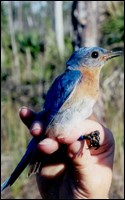
Eastern Bluebirds (Sialia sialis) are well known in the United States for their brilliant plumage, sweet song, and use of nestboxes. It is hard to imagine that this species nearly went extinct in the early 1900s because of a deadly combination of management practices that removed the dead tree snags that bluebirds depend upon for nesting, the introduction of exotic species that competed for nesting cavities, and the detrimental effects of pesticides. The recovery of populations across the eastern United States is an example of how everyday citizens can play a role in conservation. The major factor in the bluebird's recovery was the establishment of nestboxes by private landowners across their range. Eastern Bluebirds, along with several other cavity-nesting birds, were extirpated from southeastern Florida in the mid-1900s because of habitat loss that resulted from logging and fire suppression. The species was reintroduced into the rare pine rockland ecosystem of Long Pine Key in Everglades National Park during 1997-2001 as part of a large-scale restoration program. A total of 47 Eastern Bluebirds were translocated to the park from nearby Big Cypress National Preserve. In most cases, bluebirds were only moved if both the male and female of a breeding pair were captured. All of the bluebirds were healthy and in good condition when they were released. 
Initial monitoring of the reintroduced bluebird population indicated the successful establishment of bluebirds in Everglades National Park. Overall, 57 percent of the released adult bluebirds established a territory, and reintroduced individuals nested and successfully raised young, which subsequently bred successfully. At the end of the 2003 breeding season, the reintroduced Eastern Bluebird population consisted of 39 adults and 18 juveniles. Although the reintroduction resulted in the reestablishment of Eastern Bluebirds into Everglades National Park, the population was small and remained at risk of extirpation. Continued monitoring was deemed necessary to evaluate the success of the reintroduction. Additional monitoring during 2005-09 determined that the population growth of bluebirds did not increase as expected. Population levels declined to about 30 breeding individuals and bluebirds remained at risk of extirpation in the park. Explanations for the lack of population growth include poor reproduction in response to the lack of available nesting sites, increased predation, and high mortality due to collisions with automobiles along roads. Studies are needed to identify what factors are limiting bluebird populations in Everglades National Park so that management actions can be crafted for this species. Fire is the most important habitat management tool in the pine rocklands and its effects on bluebird habitat quality are not clearly understood. Prior to urban development in south Florida, suitable bluebird habitat was partly the result of regular naturally caused wildfires. Fire suppression during much of the past century has led to a buildup of vegetative undergrowth that has degraded the habitat. Since the realization in recent years of the importance of fire in maintaining a healthy ecosystem, fire is now used as a tool in the restoration of the Everglades ecosystem. ADDITIONAL RESOURCES Avian Restoration in Everglades National Park: An Evaluation of the Brown-Headed Nuthatch and Eastern Bluebird Reintroduction Program During the 2-Year Post-Translocational Period (2002-2003) Ecostudies Institute Publications |
Last updated: October 17, 2017
